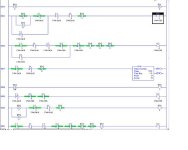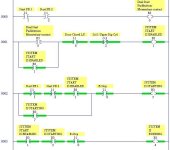I am having a problem getting the jmp and lbl logic to work in my program. I have attatched a copy of the program and would appreciate it if someone or all could take a look at it and offer some help. I have been looking at this forum for a while now and you guys are definately the best.
A brief descrition of the problem:
This machine has the option of spinning a basket either forward only or forward and then reverse depending on input I1:3. I have put in another switch to allow it to spin 4 ways succesively, fwd,rev,fwd,rev but only one time per scan when the switch is on.
I tried putting the jmp inst after the line which contains t4:dn and then labeling the line which has the external timer 0:2/5. It winds up in a loop and faults. I worked on this for 4 hours on friday and decided to ask the experts. Thanks in advance for reading this and trying to help.
A brief descrition of the problem:
This machine has the option of spinning a basket either forward only or forward and then reverse depending on input I1:3. I have put in another switch to allow it to spin 4 ways succesively, fwd,rev,fwd,rev but only one time per scan when the switch is on.
I tried putting the jmp inst after the line which contains t4:dn and then labeling the line which has the external timer 0:2/5. It winds up in a loop and faults. I worked on this for 4 hours on friday and decided to ask the experts. Thanks in advance for reading this and trying to help.





